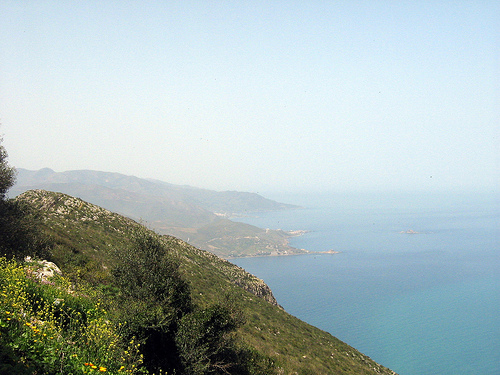

Location: Béjaïa Province Map
Area: 20.8 km²
Gouraya National Park (الحديقة الوطنية قورايا) situated in Béjaïa Province in the Northern Algeria. This natural reserve covers an area of 20.8 km² on the Mediterranean coast. Much of Gouraya National Park territory lies along the coast of Mediterranean coast. Its mild warm climate differs from the the hot and dry Sahara desert just few miles south of the protected reserve. The closest city to Gouraya National Park is Sidi Touati. It derives its name from a mountain Gouraya, the highest point here. Additionally this nature biosphere is recognized by the UNESCO for its unique landscape and particularly Barbary Macaques that are endemic to the region. Other species that call this National Park home are wild cats, Algerian hedgehog, jackals and many others. If you visit the coast you can also encounter a harbour porpoise, bottleneck dolphin and common dolphin. They are commonly seen in groups near the coast although they rarely approach land too closely. So you might want to rent a boat and travel out at sea.
Gouraya National Park located on the eastern coast of Kabylia in the wilaya of Béjaia, 230 km from Algiers, this situation puts the park in contact with other cities: 111 km north-west of Sétif, 127 km to east of Tizi Ouzou and 96 km west of Jijel. This park was created for the diversity of endemic vegetation, and its marine and continental environments as well as regional history. Located entirely in the municipality of Béjaia, it occupies an area of 2,080 ha, to which is added a marine area of 7,842 ha as well as a lake area "Lake Mézaia" with an area of 3 ha. Gouraya National Park presents archaeological riches including 15 historical sites and 9 picturesque natural areas.
The biodiversity of Gouraya
National Park consists of 1,709 species including 533 for flora and
1156 for fauna. 67 species are protected including 20 invertebrates,
1 reptile, 10 mammals, 3 plants, 33 birds.
The marine area:
Floristic and faunistic richness 173 species of zooplankton, 164
zoobenrhic species, 211 species of fish, 5 species of mammals, 55
phytoplankton species and 72 phytobenthic species including 8
so-called "remarkable" species. These are species classified
according to the "red" book: Lithophyllum lichenoîdes, Dictyopteris
membranacea, Cystoseira sedoides, Cystoseira ercegovicii, Cystoseira
stricta, Cystoseira mediterranea, Cystoseira spinosa and Posidonia
oceanica.
The Lake
Zone is made up of 37 species of birds, 43 species of invertebrates
including 4 species of dragonflies protected by law, 2 species of
fish, 3 species of amphibians, 38 species of plants. This zone is
characteristic of wetlands, mainly dominated by Phragmites communis
reeds, typha (Typha angustifolia), and species such as black poplar,
white poplar, tamarix (Tamarix africana), oleander, ash (Fraxinus
angustifolia) and 45 phytoplankton taxa.
The terrestrial
flora has 36 mammal species, 152 bird species including 10 raptor
species, 428 invertebrate species, 9 reptile species, 526 plant
species, including 81 medicinal ones including Bupleurum
plantagineum, Pennisetum asperifolium, Euphorbia dendroïdes, Galium
brunneum, Lithospermum rosmarinifolium, Bupleurum fruticosum,
Ambrosia maritima.